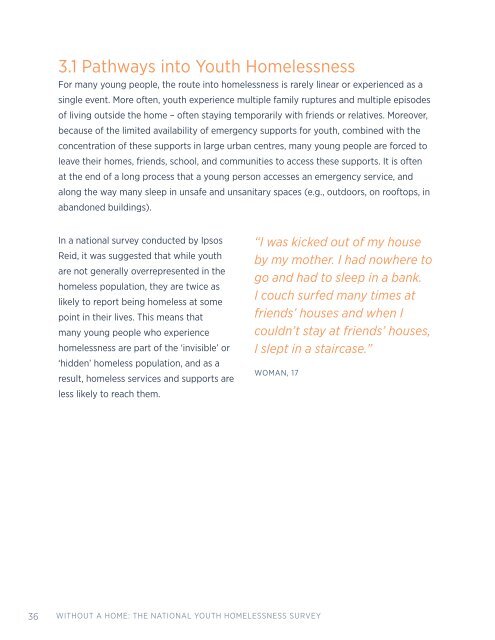Without A Home: The National Youth Homelessness Survey
You also want an ePaper? Increase the reach of your titles
YUMPU automatically turns print PDFs into web optimized ePapers that Google loves.
3.1 Pathways into <strong>Youth</strong> <strong>Home</strong>lessness<br />
For many young people, the route into homelessness is rarely linear or experienced as a<br />
single event. More often, youth experience multiple family ruptures and multiple episodes<br />
of living outside the home – often staying temporarily with friends or relatives. Moreover,<br />
because of the limited availability of emergency supports for youth, combined with the<br />
concentration of these supports in large urban centres, many young people are forced to<br />
leave their homes, friends, school, and communities to access these supports. It is often<br />
at the end of a long process that a young person accesses an emergency service, and<br />
along the way many sleep in unsafe and unsanitary spaces (e.g., outdoors, on rooftops, in<br />
abandoned buildings).<br />
In a national survey conducted by Ipsos<br />
Reid, it was suggested that while youth<br />
are not generally overrepresented in the<br />
homeless population, they are twice as<br />
likely to report being homeless at some<br />
point in their lives. This means that<br />
many young people who experience<br />
homelessness are part of the ‘invisible’ or<br />
‘hidden’ homeless population, and as a<br />
result, homeless services and supports are<br />
less likely to reach them.<br />
“I was kicked out of my house<br />
by my mother. I had nowhere to<br />
go and had to sleep in a bank.<br />
I couch surfed many times at<br />
friends’ houses and when I<br />
couldn’t stay at friends’ houses,<br />
I slept in a staircase.”<br />
WOMAN, 17<br />
36<br />
WITHOUT A HOME: THE NATIONAL YOUTH HOMELESSNESS SURVEY

















